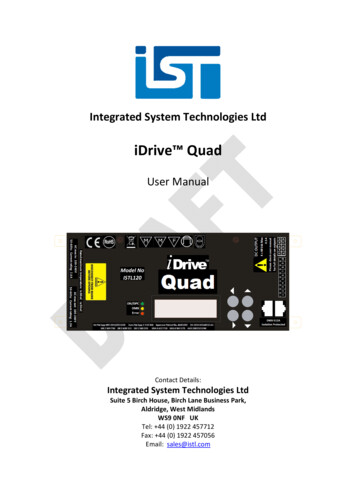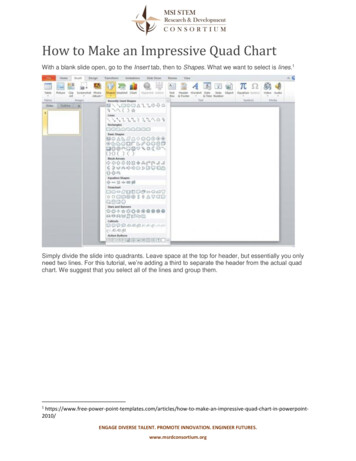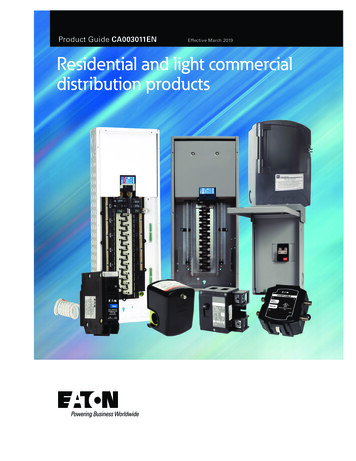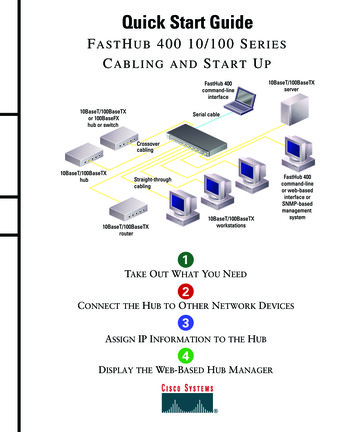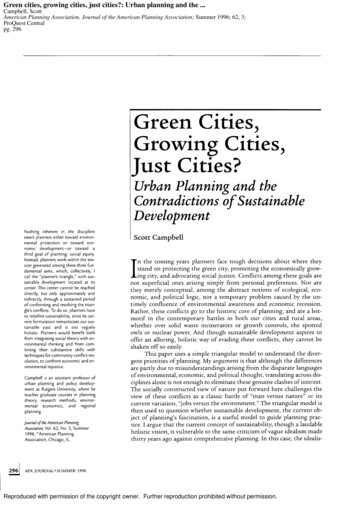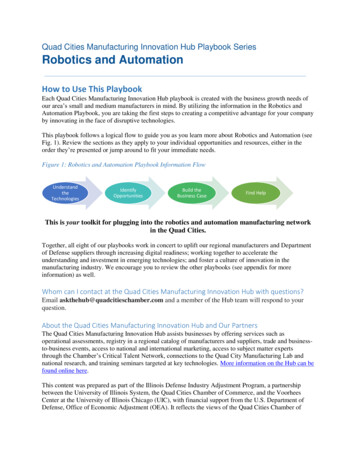
Transcription
Quad Cities Manufacturing Innovation Hub Playbook SeriesRobotics and AutomationHow to Use This PlaybookEach Quad Cities Manufacturing Innovation Hub playbook is created with the business growth needs ofour area’s small and medium manufacturers in mind. By utilizing the information in the Robotics andAutomation Playbook, you are taking the first steps to creating a competitive advantage for your companyby innovating in the face of disruptive technologies.This playbook follows a logical flow to guide you as you learn more about Robotics and Automation (seeFig. 1). Review the sections as they apply to your individual opportunities and resources, either in theorder they’re presented or jump around to fit your immediate needs.Figure 1: Robotics and Automation Playbook Information Build theBusiness CaseFind HelpThis is your toolkit for plugging into the robotics and automation manufacturing networkin the Quad Cities.Together, all eight of our playbooks work in concert to uplift our regional manufacturers and Departmentof Defense suppliers through increasing digital readiness; working together to accelerate theunderstanding and investment in emerging technologies; and foster a culture of innovation in themanufacturing industry. We encourage you to review the other playbooks (see appendix for moreinformation) as well.Whom can I contact at the Quad Cities Manufacturing Innovation Hub with questions?Email askthehub@quadcitieschamber.com and a member of the Hub team will respond to yourquestion.About the Quad Cities Manufacturing Innovation Hub and Our PartnersThe Quad Cities Manufacturing Innovation Hub assists businesses by offering services such asoperational assessments, registry in a regional catalog of manufacturers and suppliers, trade and businessto-business events, access to national and international marketing, access to subject matter expertsthrough the Chamber’s Critical Talent Network, connections to the Quad City Manufacturing Lab andnational research, and training seminars targeted at key technologies. More information on the Hub can befound online here.This content was prepared as part of the Illinois Defense Industry Adjustment Program, a partnershipbetween the University of Illinois System, the Quad Cities Chamber of Commerce, and the VoorheesCenter at the University of Illinois Chicago (UIC), with financial support from the U.S. Department ofDefense, Office of Economic Adjustment (OEA). It reflects the views of the Quad Cities Chamber of
Commerce and does not necessarily reflect the views of the OEA. For more information, please visitwww.IllinoisDIA.org.Robotics and Automation in the Quad Cities: At a GlanceWhat does “robotics and automation” for manufacturing encompass?Robotics incorporates multiple engineering disciplines to design, build, program, and use robots tocomplete tasks––in our focus, manufacturing tasks. The purpose of industrial robots varies, and caninclude movement of products, materials, parts, and tools, as well as completing a wide variety ofprogrammed tasks.1 Industrial automation involves using machines, robots, and control systems toautomate tasks within a manufacturing process. Automation uses a variety of technologies, includingcomputer hardware, software, and machines, to perform tasks usually done by human workers.2Why do robotics and automation matter to the QC manufacturing community?Robotics and automation has the capacity to augment and replace current manufacturingprocesses in the future. Workers now are producing 47% more than 20 years ago. Through thedevelopment of automation, robotics, and advanced manufacturing, the sector has bounced back alongwith the overall economy.3 As of 2018, there are 74 robot units per 10,000 employees in the globalmanufacturing industry (up from 66 units in 2015),4 and total industrial robots now working in the UnitedStates number at least 230,000.5 In three to five years, manufacturers in our region will plan for roboticsand automation opportunities when designing factory layouts, engineering and designing products, andupskilling current employees to increase efficiencies, save money, and remain competitive.What are the biggest opportunity areas locally?The Quad Cities Manufacturing Innovation Hub has identified three key opportunity areas in robotics andautomation for area manufacturers: Opportunity #1: Production efficiencies and cost savings. Most manufacturers experience ROIin 12 to 18 months after adding robotic automation.6Opportunity #2: Increased onsite safety. Robots are designed with built-in safety functionalityand are not prone to the same human errors.Opportunity #3: Employee development. Employees can develop their careers in new ways,stepping out of low skill-level tasks to explore other fields that benefit the company.What are the business benefits of utilizing robotics and automation?Though dependent on the robotics and automation opportunity area(s) you pursue, manufacturers witnessmany benefits from implementing these technologies, including lower production costs, reduced time tocomplete tasks, labor cost savings, increased onsite safety, and higher skilled employees. For a full list ofmetrics, scroll to the Metrics -difference-between-automation-and-robotics3 /how-technology-is-changing-manufacturing/4 ity-rises-globally5 ications/assets/pwc-industrial-robot-ready.pdf6 delta-robot-white-paper1.pdf2
Where can I find help to get started?There are local resources who can assist you with the development and implementation of robotics andautomation solutions, hardware, machinery, software, and applications. There are also many free onlineresources, as well as educational courses offered by Quad City universities and colleges. Later in thisplaybook we offer a full list of area resources to jump start your use of robotics and automation.Table of ContentsHow to Use This Playbook . 1Who can I contact at the Quad Cities Manufacturing Innovation Hub with questions? . 1About the Quad Cities Manufacturing Innovation Hub and Our Partners . 1Robotics and Automation in the Quad Cities: At a Glance . 2What does “robotics and automation” for manufacturing encompass? . 2Why do robotics and automation matter to the QC manufacturing community? . 2What are the biggest opportunity areas locally?. 2What are the business benefits of utilizing robotics and automation? . 2Where can I find help to get started? . 3Table of Contents . 3Understand the Technologies . 4Additional Online Resources . 7Identify Opportunities . 8Opportunity #1: Production Efficiencies and Cost Savings . 8Opportunity #2: Onsite Safety . 9Opportunity #3: Employee Development . 9Benefits and Use Cases of Robotics and Automation Opportunities . 9Build the Business Case and Begin Implementation . 12Change Management: Building the Case Requires Data and a “Test-and-Learn” Approach . 13Processes and Frameworks for Implementing Robotics and Automation . 15Resources Needed: Technology and Staffing . 16“Quick Wins” to Get Started with Robotics and Automation . 19Metrics for Success: How to Measure Impact . 20Find Help with Regional Assets and Partners . 21Robotics System Integrators . 22Electrical Engineers for Automation Solutions . 22Educational Institutions . 22Industry Organizations . 23Appendix . 23Glossary: Key Robotics and Automation Terms . 23
Understand the TechnologiesIn the first section, we take a closer look at the technologies that enable robotics and automation. You’llgain a better understanding of how robotics and automation contribute to your company’s digitaltechnology and innovation strategy through diagrams, frameworks, and definitions of key terms uses inthe space. This section also details additional online resources for greater understanding.Robotics incorporates multiple engineering anddesign disciplines to build, program, and userobots for task completion––in our focus,manufacturing tasks. Industrial robots are used bymanufacturers to move products, parts, and tools,and perform many other programmed tasks.7 Asubset of industrial robots, collaborative robots(or “cobots”) are designed to safely workalongside humans to perform manufacturing tasksthat benefit from automation but cannot yet befully automated. Cobots can also helpmanufacturers deal with labor shortage that canoccur as workers age out of their jobs, as theysupplement current employees through transitionperiods.Industrial automation involved using machines,robots, and control systems to automate tasks within a manufacturing process. Automation uses computersoftware, machines, and other technologies to carry out tasks which would otherwise be done by humanworkers.8 Various levels of automation, when combined with robotics, can complete tasks on amanufacturing floor.By 2021, IDC predicts that 20% of top-performing manufacturers will depend on a secure backbone ofembedded intelligence (using industrial Internet of Things (IIoT), blockchain, and cognitive intelligence)to automate large-scale processes and speed execution time by up to 25%.9 Both robotics and automationachieve their greatest value and traction as they’re integrated with other technologies, like data analyticsand cybersecurity programs (see related playbooks) in advanced manufacturing environments to delivergreater efficiencies and data security. Whether integrating with traditional tasks such as welding andpicking/sorting; or new technologies like additive manufacturing, machine sensors, and artificialintelligence (AI); many manufacturers are finding additional value from utilizing robotics and automationto augment and improve existing processes that have historically required human involvement. This isespecially true when considering the capabilities of collaborative robots that are more flexible and saferthan traditional industrial robotic applications.Glossary: Robotics and Automation difference-between-automation-and-robotics“IDC FutureScape: Worldwide Manufacturing 2018 Predictions” as accessed via ons.pdf9
Please refer to the glossary in the appendix for definitions of key robotics and automation terminologythat is utilized in this playbook. Definitions provided for educational purposes as described byRobots.com unless otherwise noted.Figure 1: Types of Industrial Automation Systems. Approved for reuse by ElecricalTechnology.org10Automation TypeFixed or HardAutomationProgrammableAutomationFlexible or SoftAutomationDescriptionUsesThis type of automation isOnce it is employed, it is relatively hard toemployed to perform fixed andchange or vary the product design. Therefore, itrepetitive operations in order tois inflexible in providing product variety, butachieve high production rates. Itincreases the efficiency with higher productionuses special purpose or dedicatedrate and reduces unit cost. Some of theseequipment to automate the fixedautomated systems are distilled process, paintsequence assembling orshops and conveyors.processing operations.In this automation, a specific class This automation is best suited for batchof product changes and alsoproduction process where product volume isassembling or processingmedium to high. But in this, it is hard to changeoperations can be changed withand reconfigure the system for a new product orthe modification of controlsequence of operations. It requires a long setup.program in the automatedExamples of this automation system areequipment.numerically controlled machines, paper mills,steel rolling mills, and industrial robots.This automation system providesThis automation allows the manufacturers tothe automatic control equipmentproduce multiple products with different rangesthat offers a great flexibility foras a combined combination process rather thanmaking changes in the productseparate. Some of the examples of thisdesign. These changes can beautomation system are automatic guidedperformed quickly through thevehicles, automobiles, and multipurpose CNCcommands given in the form ofmachines.codes by the human operators.Figure 2. Types and Classifications of Robots2.1 Below diagram and description, via OSHA11Industrial robots are available commercially in a wide range of sizes, shapes, and configurations. They aredesigned and fabricated with different design configurations and a different number of axes or degrees offreedom. These factors of a robot's design influence its working envelope (the volume of working orreaching space). Diagrams of the different robot design configurations are shown .osha.gov/dts/osta/otm/otm iv/otm iv 4.html
2.2 A closer look at articulated arm robot anatomy. Approved for reuse by ICT Lounge12 :12https://www.ictlounge.com/html/applications in manufacturing.htm
2.3 Capabilities of Traditional Robots vs. Collaborative Robots (“Cobots”). Approved for reuse byUniversal Robots.13 Collaborative robots are designed to work alongside human workers, in operationsthat cannot be fully automated.Figure 3: Benefits of Robotics Process Automation, via Capgemini Consulting14Additional Online ResourcesThere are many online resources for review to deepen your understanding of robotics and automationmachinery, software, applications, technologies, use cases, opportunities, challenges, and more. We’veoutlined a few /2017/08/robotic-process-automation-study.pdf
Automate this: The business leader’s guide to robotic and intelligent automation, viaDeloitte. Read the whitepaper guide here. In this guide, you’ll find the nuts and bolts of processand enterprise automation in manufacturing. Additionally, find common myths debunked relatedto intelligent automation, ways to get started step-by-step with robotics, as well as a glimpse intothe future of manufacturing automation.The new hire: How a new generation of robots is transforming manufacturing, via PWC.Download the report here. This report delves into how the rise of robots in manufacturing hascreated new jobs in new industries, how current workers can interact with robots, and how thecollaboration creates a new workforce. You’ll also find outlines of the benefits of flexibility andcompetitiveness, definitions of barriers to widespread adoption, cost breakdowns, and a handyself-assessment of your readiness for robotics.Robot-ready: Adopting a new generation of industrial robots, via PWC. Download thewhitepaper here. This report focuses on the automation of physical tasks as opposed toinformation-driven processes (eg. RPA, “robotics process automation”). You’ll learn thecapabilities and strategies companies need to harness to best optimize returns on investments in—and deployment of—robotics in manufacturing.Identify OpportunitiesAnalyst firm IDC forecasts that industrial robotic solutions will account for the largest share of roboticsspending in the market (more than 57%) in 2018. Discrete and process manufacturing will be the leadingindustries for robotics spending at more than 54 billion combined this year!15The time to act to stay competitive is now. As a high-level guide, assessment of manufacturing processesthat can be robotically automated should follow the general guidelines from Capgemini Consulting listedbelow. These include not only manufacturing floor tasks (as typically associated with manufacturing“robotics and automation”), but also back-office tasks that involve other data systems, software, and evenERP. Examine tasks of medium complexity and frequency of process, as well as those that takeapproximately 15 minutes of medium-value work.16 Repetitive tasks carried out at least 50x per dayProcess list and file storagePeriodic reporting, data entry, and data analysisMass email generation, archiving, and extractingConversion of data and graphicsERP and other back-office transactions (See the ERP playbook for more opportunities)Robotics and automation opportunities abound for manufacturers or all sizes, including those small andmedium manufacturers in the Quad Cities. The Hub has identified three key areas that can bring greatestbenefit to our area’s small and medium manufacturers: production efficiencies and cost savings; onsitesafety; and employee development.Opportunity #1: Production Efficiencies and Cost ation-study.pdf
Manufacturers find robotics and automation to offer significant return on investment, as robots continueto decline in cost (see Fig. 4, at right). Most manufacturers experience ROI in 12 to 18 months afteradding robotic automation.17 When used to complete repetitious and menial manufacturing tasks, moreproduct can be produced withoutquality slipping. Robotics andautomation achieve the greatest costsavings within manufacturingenvironments that require high outputand no-to-low margins of error, thoughas production shifts to smaller lots ofdifferent products, companies will lookto achieve shorter time-to-market andrely on robots for quick, localcustomization.Opportunity #2: Onsite SafetyThe addition of robotics to amanufacturing environment reducesworker injury rates, especially in caseswhere employees would be workingwith typically dangerous equipment.This is also a great asset to third-shift workers that may become more easily fatigued and prone to errorduring their shift. Robots are designed with all required safety functionality and are not prone to the samehuman errors, though necessary safety precautions must still be taken when integrating robots intocollaborative manufacturing situations.Opportunity #3: Employee DevelopmentThe addition of robotics and automation to a manufacturing company gives its employees the chance todevelop their careers in new ways, stepping out of their menial or low skill-level tasks to explore otherfields that benefit the company. These may include learning to operate robots, performing more intricateor customized manufacturing assignments, focus on continuing education, or even innovation for thecompany. Robots may cause short-term job displacements, but long-term benefits to workers as theydevelop new skills and pursue jobs of greater impact, fulfillment, and salary. In turn, this boostsdisposable income and positive economic impact over time.Benefits and Use Cases of Robotics and Automation OpportunitiesIn this section, we’ll examine the key benefits of utilizing robotics and automation in each of the threeopportunity areas previously identified. Below, you’ll also find a case example for each opportunity areathat shows how a manufacturer was able to utilize robotics and/or automation to produce results.Opportunity #1: Production Efficiencies and Cost Savings 17Increased efficiency and faster throughput: Industrial robots can perform tasks quicker thanhumans, decreasing cycle time. Robots can work around the clock as well, enabling 24/7operations.Flexibility and scalability: Once a process has been defined as a series of instructions for robotexecution, it can be scheduled for a particular time––either for one robot, or many working h-delta-robot-white-paper1.pdf
unison. Robots can also be programmed to prioritize tasks, if one to-do is more important thananother in an evolving scenario—as each robot is typically capable of performing many actions.Improved accuracy: Robots are programmed to follow rules and rarely make mistakes.Ease of integration with existing machinery: According to McKinsey, advances in computingpower, software development, and networking technologies have made assembling, installing,and maintaining robots faster and less costly than before.18 Look for experience and industryexpertise in a systems integrator that is tailored to your individual needs. Consider the integrationneeded to complement other new technologies as well––such as additive manufacturing, artificialintelligence, data sensors, and more.Real-time data gathering: Robot tasks can be monitored and analyzed at every step, producingvaluable data that can support process improvement over time, and also help with regulatorycompliance.19 McKinsey also reports that, “robotic sensors and actuators can also monitorthemselves and report their status to the control system, to aid process control and collect data formaintenance, and for continuous improvement and troubleshooting purposes.”20 Learn moreabout how to craft your data analytics strategy in our Data Analytics playbook.Case Example #1: Vision-guided collaborative robots deliver fast return on investment in production offirehose valves21Task Force Tips, an Indiana-based manufacturerof firefighting equipment, wanted to promote andmaximize their personnel tending machining cellsinto more complex tasks while keeping spindletime up and product quality consistent. Themanufacturer has now installed four collaborativerobots, working alongside employees, to deliversavings resulting in a return on their investmentin only 34 days. Task Force Tips installed threerobots to tend CNC machines, and a fourth ismounted to a table on wheels and moved betweentasks. Now, it only takes one hour per operatorper shift to operate the robot, which includes laying out parts and staging the robot. That translates intothe robot running for 21 hours unassisted and seven hours of time saved in each employee shift, freeingthem up to do something else more productive.Case Example #2: Harley Davidson Detects Defects and Streamlines ProductionHarley Davidson uses smart systems to detect defects during production processes at its York, Penn.,plant. Sensors monitor equipment performance and initiate action autonomously. Upon detection ofmeasurement anomalies (of everything from humidity or temperature) beyond acceptable ranges, themachinery is automatically adjusted, preventing malfunctions.22 As reported in the Wall Street Journal,the data allows Harley Davidson to streamline production, eliminate bottlenecks, and anticipate problemspredictively. Since implementation, Harley Davidson completes a new bike every 86 -operations/us-sdt-process-automation.pdf20 ory-of-the-future21 d 59622 Documents/energy-resources/ZA .pdf23 ternet-of-things/19
Case Example #3: Ridgeline Pipe Manufacturing Anticipates Demand and Auto-Adjusts ProductionRidgeline Pipe Manufacturing adopted a “flexible production system” to combat challenges of shiftingcustomer demand, short lead times, and inefficient production changeover. With the autonomous system,the company is able to predict demand and adjust production accordingly via automated productioncontrollers that react to real-time diagnostic performance data. Ridgeline is also able to analyzeproduction data in order to predict machine failure ahead of an emergency or downtime.24Opportunity #2: Onsite Safety Fewer accidents and injuries: Many robot safety features and technologies have existed forquite some time with proven success, with robotic developers and integrators using safe zones,fencing, and other technologies to ensure safe robot operation. Though accidents can happen, it’srare, and they’re often caused by either operator error, setup mistakes, or entering a robot’soperating zone.25 Robots also oftentimes take on more dangerous or ergonomically challengingtasks, lessening the chance for worker on-the-job injury.Faster reactions: Industrial robots take up less space than they used to, and are armed withcountless sensors to help increase reaction time, use appropriate force, and stop production whennearing humans or other collision points. If sensors indicate the risk of a collision with anoperator, the robot will automatically slow down or alter its path to avoid it.No safety training needed: Control Engineering reports on the safety of collaborative robots,stating they are, “designed to understand their environment and interact with people, which isunlike a traditional robot that works on the assembly line. These technologies are intended todevelop the natural interfaces that allow for the operation of complex robotic systems with lesstraining and expended energy.”26Case Example: Ford Uses Collaborative Robots for Heavy Lifting, Outlook to Eliminate Employee RepetitiveStrain Injuries27Ford Motor Co. has been testing new collaborative robots fromKUKA Robotics at its assembly plant in Cologne, Germany, onan assembly line helping workers install shock absorbers. Ratherthan use a heavy shock absorber installation tool, the workershave the robot lift and automatically position the shock into thewheel arch before pushing a button to install the component.Working overhead with heavy air-powered tools is a tough jobthat requires strength, stamina, and accuracy. For manyautomotive applications in particular, collaborative robots that can lift a substantial amount of weight,show a lot of promise for alleviating a number of repetitive strain injuries among workers. Thecollaborative robots also stop immediately if they detect an arm or even a finger in their path, ensuringultimate worker safety.Opportunity #3: Employee nufacturing as accessed via Documents/energyresources/ZA 6.pdf25 rst-robotic-automation/26 1971ca291fdaf1fdbae27df2.html27 rst-robotic-automation/
“Upskilling” of workers: Workers whose tasks are augmented by or fully replaced by roboticshave the chance to develop their careers into new roles that will be created by automation. WorldEconomic Forum predicts that, “as robots take over the most repetitive and arduous tasks, humanswill transition to less physically demanding and straining roles,” 28 learning new skills in theprocess.Larger talent pools: McKinsey analysts find that people with the skills required to design,install,
Why do robotics and automation matter to the QC manufacturing community? Robotics and automation has the capacity to augment and replace current manufacturing processes in the future. Workers now are producing 47% more than 20 years ago. Through the development of automation, robotics, and
